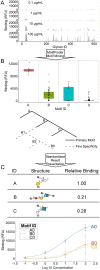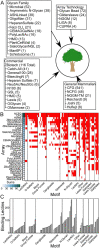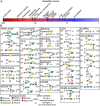CarboGrove: a resource of glycan-binding specificities through analyzed glycan-array datasets from all platforms
- PMID: 35352123
- PMCID: PMC9280547
- DOI: 10.1093/glycob/cwac022
CarboGrove: a resource of glycan-binding specificities through analyzed glycan-array datasets from all platforms
Abstract
Glycan arrays continue to be the primary resource for determining the glycan-binding specificity of proteins. The volume and diversity of glycan-array data are increasing, but no common method and resource exist to analyze, integrate, and use the available data. To meet this need, we developed a resource of analyzed glycan-array data called CarboGrove. Using the ability to process and interpret data from any type of glycan array, we populated the database with the results from 35 types of glycan arrays, 13 glycan families, 5 experimental methods, and 19 laboratories or companies. In meta-analyses of glycan-binding proteins, we observed glycan-binding specificities that were not uncovered from single sources. In addition, we confirmed the ability to efficiently optimize selections of glycan-binding proteins to be used in experiments for discriminating between closely related motifs. Through descriptive reports and a programmatically accessible Application Programming Interface, CarboGrove yields unprecedented access to the wealth of glycan-array data being produced and powerful capabilities for both experimentalists and bioinformaticians.
Keywords: binding specificity; database; glycan-binding protein; lectin; microarray.
© The Author(s) 2022. Published by Oxford University Press.
Figures






Similar articles
-
Combined Analysis of Multiple Glycan-Array Datasets: New Explorations of Protein-Glycan Interactions.Anal Chem. 2021 Aug 10;93(31):10925-10933. doi: 10.1021/acs.analchem.1c01739. Epub 2021 Jul 28. Anal Chem. 2021. PMID: 34319080 Free PMC article.
-
Global comparisons of lectin-glycan interactions using a database of analyzed glycan array data.Mol Cell Proteomics. 2013 Apr;12(4):1026-35. doi: 10.1074/mcp.M112.026641. Epub 2013 Feb 11. Mol Cell Proteomics. 2013. PMID: 23399549 Free PMC article.
-
A motif-based analysis of glycan array data to determine the specificities of glycan-binding proteins.Glycobiology. 2010 Mar;20(3):369-80. doi: 10.1093/glycob/cwp187. Epub 2009 Nov 29. Glycobiology. 2010. PMID: 19946132 Free PMC article.
-
The detection and discovery of glycan motifs in biological samples using lectins and antibodies: new methods and opportunities.Adv Cancer Res. 2015;126:167-202. doi: 10.1016/bs.acr.2014.11.003. Epub 2015 Feb 7. Adv Cancer Res. 2015. PMID: 25727148 Free PMC article. Review.
-
Use of glycan microarrays to explore specificity of glycan-binding proteins.Methods Enzymol. 2010;480:417-44. doi: 10.1016/S0076-6879(10)80033-3. Methods Enzymol. 2010. PMID: 20816220 Review.
Cited by
-
Glucose-dependent glycosphingolipid biosynthesis fuels CD8+ T cell function and tumor control.Cell Metab. 2025 Jul 30:S1550-4131(25)00333-X. doi: 10.1016/j.cmet.2025.07.006. Online ahead of print. Cell Metab. 2025. PMID: 40769148
-
Mass Spectrometry-Based Glycoproteomic Workflows for Cancer Biomarker Discovery.Technol Cancer Res Treat. 2023 Jan-Dec;22:15330338221148811. doi: 10.1177/15330338221148811. Technol Cancer Res Treat. 2023. PMID: 36740994 Free PMC article. Review.
-
The crystal structure of Nictaba reveals its carbohydrate-binding properties and a new lectin dimerization mode.Glycobiology. 2024 Dec 10;34(12):cwae087. doi: 10.1093/glycob/cwae087. Glycobiology. 2024. PMID: 39437181 Free PMC article.
-
LeGenD: determining N-glycoprofiles using an explainable AI-leveraged model with lectin profiling.bioRxiv [Preprint]. 2024 Mar 30:2024.03.27.587044. doi: 10.1101/2024.03.27.587044. bioRxiv. 2024. PMID: 38585977 Free PMC article. Preprint.
-
Boltzmann Model Predicts Glycan Structures from Lectin Binding.Anal Chem. 2024 May 28;96(21):8332-8341. doi: 10.1021/acs.analchem.3c04992. Epub 2024 May 8. Anal Chem. 2024. PMID: 38720429 Free PMC article.
References
-
- Bryan MC, Fazio F, Lee H-K, Huang C-Y, Chang A, Best MD, Calarese DA, Blixt O, Paulson JC, Burton D, et al. Covalent display of oligosaccharide arrays in microtiter plates. J Am Chem Soc. 2004:126(28):8640–8641. - PubMed

